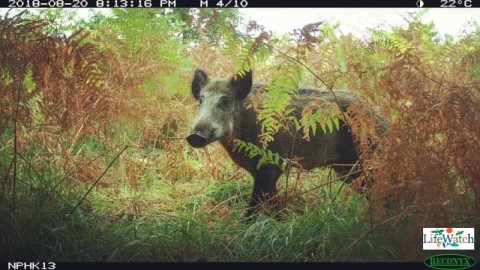PhD research reveals wild boar behaviour
Jolien Wevers successfully defended her PhD research on wild boar and roe deer ecology in a human-dominated landscape at Hasselt University.

Jolien used the LifeWatch camera trap infrastructure (CATREIN) for investigating how wild boar [Sus scrofa (Linnaeus, 1758)] and roe deer [Capreolus capreolus (Linnaeus, 1758)] cope with human disturbance in a strongly urbanised environment at different temporal and geographical scales, and at different levels of intensity of human disturbance. 40 cameras registered wildlife presence and behaviour in the National Park Hoge Kempen in a collaboration between Hasselt University, INBO and LifeWatch Flanders. 4 years and millions of images later, the PhD-research has been finished.
In general, animals tend to respond to human disturbance by separating themselves from humans by shifting their activity patterns or by using (suboptimal) habitats to avoid humans on a temporal, a spatial scale or both. The findings of the doctoral thesis implicate that the space use of both wild boar and roe deer is mainly driven by environmental variables (such as forest availability) rather than being limited by human presence. Wild boar display clever and opportunistic behaviour and avoid human contact by adapting their time use. At sunset, they are active in quiet areas without disturbance. Areas with many hiking trails or where hunting is allowed are only visited in the middle of the night. Roe deer on the other hand, do not actively avoid areas with human disturbance, but they do adjust their activity pattern. Instead of being very active at dawn and dusk, they are more active at night.
For more information:
News items (in Dutch)
Publications
In general, animals tend to respond to human disturbance by separating themselves from humans by shifting their activity patterns or by using (suboptimal) habitats to avoid humans on a temporal, a spatial scale or both. The findings of the doctoral thesis implicate that the space use of both wild boar and roe deer is mainly driven by environmental variables (such as forest availability) rather than being limited by human presence. Wild boar display clever and opportunistic behaviour and avoid human contact by adapting their time use. At sunset, they are active in quiet areas without disturbance. Areas with many hiking trails or where hunting is allowed are only visited in the middle of the night. Roe deer on the other hand, do not actively avoid areas with human disturbance, but they do adjust their activity pattern. Instead of being very active at dawn and dusk, they are more active at night.
For more information:
News items (in Dutch)
Publications
- Wevers, J.; Fattebert, J.; Casaer, J.; Artois, T.; Beenaerts, N. (2020) Trading fear for food in the Anthropocene: How ungulates cope with human disturbance in a multi-use, suburban ecosystem, Science of The Total Environment, vol. 741, 1 November 2020, 140369
- Wevers, J.; Beenaerts,N.; Casaer, J.; Zimmermann, F.; Artois, T.; Fattebert, J. (2021) Modelling species distribution from camera trap by-catch using a scale-optimized occupancy approach, Remote Sensing in Ecology and Conservation
- Follow the Instagram account of Jolien Wevers to stay updated about her research
- Read more about the LifeWatch camera trap infrastructure
- Watch a clip about wild boar in nature
- UHasselt: Natalie.Beenaerts@uhasselt.be
- INBO: jim.casaer@inbo.be



